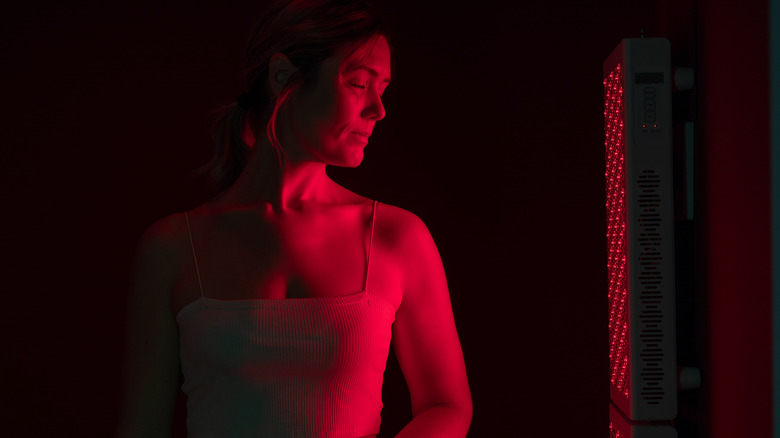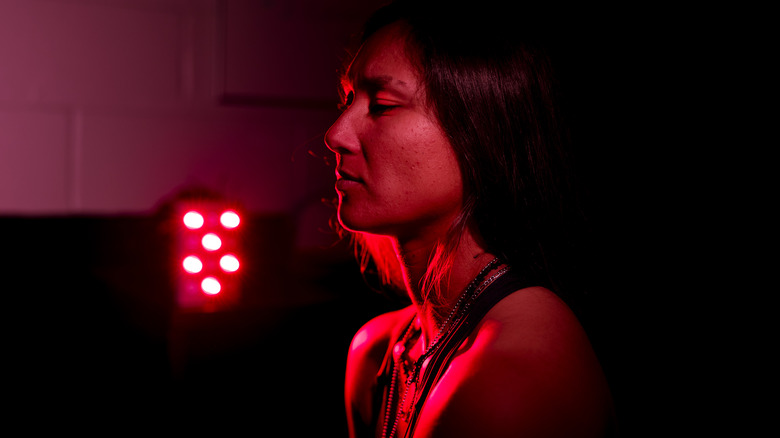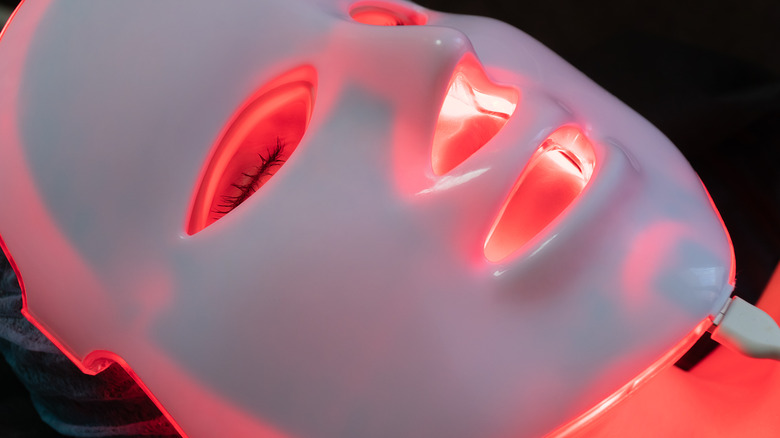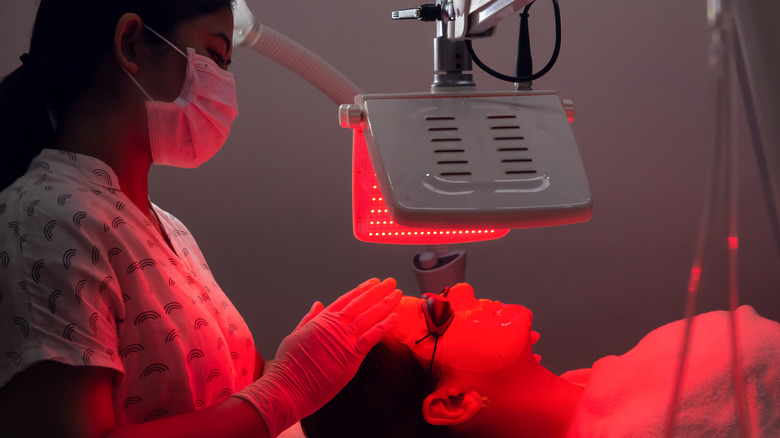Why Red Light Therapy Is A Game Changer For Your Skin
Between serums, toners, masks, and moisturizers, it feels like there are a million different ways to help keep your skincare game on point. However, while you might have conquered topical techniques, did you know that you might also need to add light to your skincare routine? Before you start thinking about your daily battle with blue light, we're actually talking about light with potentially major benefits for the skin. Red light therapy is the latest beauty trend gaining popularity, and chances are you've probably already spotted an influencer (or two) donning slightly spooky-looking LED light masks and singing the praises of what red light therapy can do.
If you're wondering what exactly red light therapy does for you, board-certified clinical psychologist, Dr. Julie Landry explained to The Everygirl, "Red light therapy is a novel light-driven treatment that applies low-level lasers or light-emitting diodes [LEDs] to deliver red [light targeting] a variety of tissues, including the central nervous system and the brain." In short, this therapy allows your cells to absorb red light wavelengths through your skin. Despite potential health benefits ranging from reducing inflammation to increasing circulation, the real reason these low wavelengths are currently gaining popularity is because of their potential to improve your skin. Red light therapy has shown promising results in a variety of skincare-focused areas including reducing wrinkles, redness, and even acne. Studies are also exploring the potential of red light therapy in boosting collagen and improving tissue healing. Let's just say we're definitely intrigued.
How does red light therapy work?
A fun fact about red light therapy is that it was actually first really explored by NASA in order to both grow plants in space (hello space potatoes) and to help heal astronaut's wounds. From this, red light therapy was widely incorporated into the medical community as part of photodynamic therapy (which is used to activate photosensitive drugs in order to destroy targeted cells). Red light therapy is currently medically used in the treatment of skin cancer, psoriasis, acne, and even warts.
The science behind red light therapy is that light exposure can produce positive biochemical effects inside your cells, which in turn helps to strengthen your mitochondria (you know, that thing from high school we all inexplicably remember as the 'powerhouse of the cell'). By increasing oxygen and electron movement, red light essentially helps increase the energy in your cells. This energy then ensures your cells are not only operating more efficiently but that they can actually repair themselves. Studies have found that LED-produced red light therapy can help to increase blood flow, collagen levels, and fibroblast production while reducing inflammation. There are also promising studies on the effectiveness of red light therapy in reducing depression.
How you can try red light therapy
Red light therapy's popularity has made it more readily available at salons and even gyms, in addition to being an option with some healthcare providers and/or dermatologists. Different locations will offer different red light therapies ranging from masks to full-body treatments. Most of these available treatments use LED lights as opposed to laser-focused therapy, and pricing can largely depend on your area and the kind of treatment offered. It's important to remember that red light therapy generally needs multiple ongoing sessions in order to see results, so the process can take a bit of patience. This can also lead to added expense if you have to regularly visit a spa to continue treatment.
With that being said, the increasing popularity of red light therapy has led to a glut of at-home device options like masks and wands. These tools can make the process of ongoing treatments easier than ever. Plus, at-home devices can be especially significant if you're one of the many people whose medical insurance does not cover red light therapy. With that being said, making sure to only purchase FDA-approved devices and to be extremely careful when using your at-home device is vitally important. Always consult with your medical provider before starting a new at-home therapy like this one.
Things to keep in mind
As much as influencers and anecdotal evidence might suggest, red light therapy is not actually a sure thing. In fact, red light therapy is still currently being tested for effectiveness in the treatment of skin conditions (like anti-aging, complexion healing, etc.) and some studies have even called into question red light therapy's ability to increase cancer cell aggression. So, using red light therapy for things like wrinkles is not only not a proven science, but is also not necessarily an option for everyone. While the therapy has definitely shown promising results across a myriad of medical uses, the full picture of what red light therapy can and cannot do is simply not yet known.
Another thing to consider with red light therapy is safety. While red light itself is not linked to any known side effects and is thought to be non-toxic (unlike, say, repeated UV exposure), there has been no testing on the long-term safety of many of the red-light therapy devices and tools that are on the market for at-home therapy uses. At-home devices can have less powerful wavelength frequencies, making them less effective than treatments you might receive from professionals. Plus, misuse or overuse of red light therapy can lead to skin and even eye damage. It is always best to receive skin treatments (or to at least have a medical conversation about potential skin therapies) from a licensed dermatologist or aesthetician, especially if you're looking to treat chronic skin conditions.



